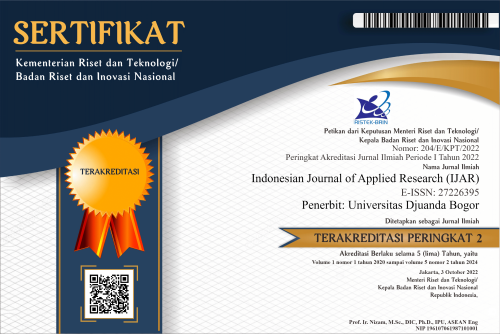Performance of The Best Solution for The Prohibited Route Transportation Problem by an Improved Vogel's Approximation Method
Abstract
The transportation problem (TP) is a significant factor in operational research. Numerous researchers have put forth various solutions to these problems. The goal is to reduce the overall cost of distributing resources from multiple sources to numerous destinations. If there are road risks (snow, flood, etc.), traffic limitations, etc., it might not be feasible to transport products from one place to another. In these circumstances, the appropriate route(s) can be given an extremely high unit cost, such as M (or). Following that, a specific case of the prohibited transportation problem is introduced. Therefore, the focus of this study is to provide a novel algorithm that will reduce the cost of restricted transportation problems. With a few modifications, the traditional Vogel approach has been enhanced. The proposed method would perform better than the other approaches now in use. The numerical problem is resolved to demonstrate the effectiveness of the proposed approach and make comparisons with different approaches already in use.
References
Amulu Priya, S., & Maheswari, V. (2022). New Vogel’s Approximation Method (NVAM) to Determine Better Feasible Solution of Transportation Problem. Mathematical Statistician and Engineering Applications, 71(3), 1385–1397.
Balakrishnan, N. (1990). Modified Vogel’s approximation method for the unbalanced transportation problem. Applied Mathematics Letters, 3(2), 9–11.
Bharathi, K., & Vijayalakshmi, C. (2016). Optimization of multi-objective transportation problem using evolutionary algorithms. Global Journal of Pure and Applied Mathematics, 12(2), 1387–1396.
Currin, D. (1986). Transportation problems with inadmissible routes. Journal of the Operational Research Society, 37(4), 387–396.
Ekanayake, E. M. U. S. B., Daundasekara, W. B., & Perera, S. P. C. (2022). An Examination of Different Types of Transportation Problems and Mathematical Models. American Journal of Mathematical and Computer Modelling, 7(3), 37–48.
Ekanayake, E., Perera, S., Daundasekara, W., & Juman, Z. (n.d.). A Modified Ant Colony Optimization Algorithm for Solving a Transportation Problem.
Hitchcock, F. L. (1941). The distribution of a product from several sources to numerous localities. Journal of Mathematics and Physics, 20(1–4), 224–230.
Jude, O., Idochi, O., & Ihuoma, I. A. (2016). Comparison of existing methods of solving linear transportation problems with a new approach. Int. J. Innov. Sci. Math., 4, 158–163.
Kaur, L., Rakshit, M., & Singh, S. (2018). A new approach to solve Multi-objective Transportation Problem. Applications and Applied Mathematics: An International Journal (AAM), 13(1), 10.
Małachowski, J., Żurek, J., Ziółkowski, J., & Lęgas, A. (2019). Application of the transport problem from the criterion of time to optimize supply network with products "fast-running". Journal of KONBiN, 49(4), 127–137.
Mhlanga, A., Nduna, I. S., Matarise, F., & Machisvo, A. (2014). Innovative application of Dantzig's Northwest Corner rule to solve a transportation problem. International Journal of Education and Research, 2(2), 1–12.
Nomani, M. A., Ali, I., & Ahmed, A. (2017). A new approach for solving multi-objective transportation problems. International Journal of Management Science and Engineering Management, 12(3), 165–173.
Prah, J. A., Acheson, V., Barnes, B., Takyi, I., & Owusu-Ansah, E. (2022). A 2-Phase Method for Solving Transportation Problems with Prohibited Routes. Pakistan Journal of Statistics and Operation Research, 749–758.
Shaikh, M., Shah, S., & Memon, Z. (n.d.). An Improved Algorithm to Solve Transportation Problems for Optimal Solution.
Srirangacharyulu, B., & Srinivasan, G. (2010). Completion time variance minimization in single machine and multi-machine systems. Computers & Operations Research, 37(1), 62–71.
Taha, H. A. (2011). Operations research: An introduction (Vol. 790). Pearson/Prentice Hall Upper Saddle River, NJ, USA.
Ufuoma, O. (n.d.). A Clear Conception of Zero and Infinity with Practical Illustrations.
Ullah, M., Mahmood, A., Razzaq, S., Ilahi, M., Khan, R., & Javaid, N. (2013). A survey of different residential energy consumption controlling techniques for autonomous DSM in future smart grid communications. ArXiv Preprint ArXiv:1306.1134.
Ziółkowski, J., & Lęgas, A. (2019). Problem of modelling road transport. Journal of KONBiN, 49(3), 159–193.
Copyright (c) 2022 Indonesian Journal of Applied Research (IJAR)

This work is licensed under a Creative Commons Attribution-ShareAlike 4.0 International License.
The Authors submitting a manuscript do so on the understanding that if accepted for publication, copyright publishing of the article shall be assigned/transferred to Indonesian Journal of Applied Research (IJAR) Universitas Djuanda as Publisher of the journal. Upon acceptance of an article, authors will be asked to complete a 'Copyright Transfer Agreement'. An e-mail will be sent to the corresponding author confirming receipt of the manuscript together with a 'Copyright Transfer Agreement' form by online version of this agreement.
Indonesian Journal of Applied Research (IJAR) Universitas Djuanda, the Editors and the Editorial Board make every effort to ensure that no wrong or misleading data, opinions or statements be published in the journal. In any way, the contents of the articles and advertisements published in the Indonesian Journal of Applied Research (IJAR) Universitas Djuanda are sole and exclusive responsibility of their respective authors and advertisers.
Remember, even though we ask for a transfer of copyright, our journal authors retain (or are granted back) significant scholarly rights as mention before.
The Copyright Transfer Agreement (CTA) Form can be downloaded here: Copyright Transfer Agreement-IJAR 2020
The copyright form should be signed electronically and send to the Editorial Office e-mail below:
Prof. Dr. Ir. Dede Kardaya, M.Si. (Editor-in-Chief)
Universitas Djuanda
Jl. Tol Jagorawi No.1, Ciawi, Kec. Ciawi, Bogor, Jawa Barat 16720
Website: http://journal.unida.ac.id/index.php/IJAR/index
Email: ijar@unida.ac.id






 This work is licensed under a
This work is licensed under a 